Clash cymbals
Clash cymbals (also called concert cymbals or orchestral cymbals) are cymbals played in matched pairs by holding one cymbal in each hand and striking the two together.
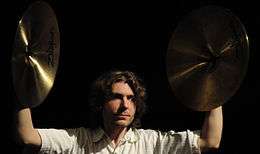
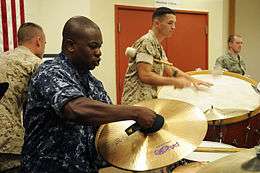

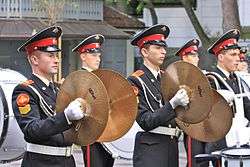 Two sets of clash cymbals in use in a marching band | |
| Percussion instrument | |
|---|---|
| Classification | Percussion |
| Hornbostel–Sachs classification | 111.142 (Cymbals: Vessel clappers with everted rim) |
They are also called hand cymbals; however, a hand cymbal can also be a suspended cymbal struck by hand rather than with a beater, and western types are often called crash cymbals; however, a crash cymbal is more commonly a medium-sized and strongly tapered suspended cymbal struck with a drum stick.
Terminology
In musical scores, clash cymbals are normally indicated as cymbals or sometimes simply C.C. If another type of cymbal, for example a suspended cymbal, is required in an orchestral score, then for historical reasons this is often also indicated cymbals. Some composers and arrangers use the plural cymbals or crash cymbals to indicate clash cymbals, with the singular cymbal to indicate a suspended cymbal.
Composers will often condense the clash cymbals and a suspended cymbal into the same part. There are a number of techniques used to indicate which is desired. Whenever with stick or with mallet is written, a suspended cymbal is used. A return to clash cymbals can be specified with the Italian phrase a 2. Russian composers developed a notation to differentiate between clash and suspended cymbals in which a + (plus sign) is written over a note to be played on suspended cymbal and a ° (open circle) is written over a note to be played with clash cymbals.
Designers of various sound banks, such as the Garritan Personal Orchestra, distinguish between handheld and suspended cymbals by referring to the former as "Piatti cymbals", having already reserved the term "crash cymbal" for the latter. Since "piatti" is the Italian term for "cymbal", this may be an awkward, redundant term.
Technique
.png)
Marching Bands
Clash cymbals are conventionally played by a standing percussionist. In a marching band context, the stationary percussionist prepares for the crash by holding the cymbals parallel a few inches apart, with the surfaces vertical, one at waist height and the other some distance above it. They are struck together by bringing the upper cymbal down and the lower up to meet in approximately the middle. If only a single crash is to be played, the sounding cymbals are then raised in a follow-through and held vertical but no longer parallel, but instead in roughly the same plane with their concave surfaces facing the audience and head-high on either side of the percussionist. This allows the cymbals to resonate freely. Alternatively, if another stroke is to follow, the cymbals are allowed to follow through only until they have reached the same heights as they started (but now vertically reversed), and are then ready in position for the next stroke. For softer strokes, in preparation the cymbals are held not quite vertically but at a slight angle, but still parallel, and the upper cymbal is then allowed to fall towards the lower. The follow-through is reduced or even omitted after softer strokes. Because clash cymbals can be maneuvered like pom-poms or other handheld devices, cymbalists will often employ various feats of showmanship, such as spinning and flashing, striking cymbals between cymbalists, or creating visual designs. Some of these serve a functional purpose—waving cymbals after a grand stroke allows for the clash to resonate more clearly; others are purely decorative—a cymbal line moving in quick pace during a field show can simulate airplanes or dragons. Also, there are numerous techniques for playing cymbals, many very different from those listed above.
Orchestras and Wind Bands
In an orchestral or wind band context, the cymbals are typically held parallel a few inches apart at chest height. For best crashes, the cymbals are held just off vertical, at a slight angle. For piano crashes the cymbals are brought together from centimetres apart and allowed to 'fizz' for a millisecond. Whereas for forte crashes, using both arms in an upward sweeping motion (as if you were rolling your arms and shoulders back and round to the front in circles), the cymbals are brought together with equal force from left and right hands. Ideally, the percussionist would allow the edge furthest away from his or her body to make contact first, with the rest following milliseconds later. They are rarely held almost horizontal, with the left cymbal on bottom. This is widely recognised as terrible technique and does not bring out anything from the cymbals other than a very weak 'crash' with no depth of sound or timbre. Other common techniques are to choke the sounding cymbals by bringing them together and then damping one or both against the body. A skilled percussionist can produce elaborate rhythms, and with fine cymbals can exercise precise control over the loudness and decay and apparent duration of each crash. Less skilled percussionists, children, and cartoon characters are often seen playing cymbals by beating them together with a purely horizontal motion. This technique has even been used by some avant-garde composers, but generally produces poor control of the sound and risks damage to fine cymbals, which are not designed for such usage.
Hi-hat stands
A drum kit normally contains one pair of clash cymbals mounted on a pedal-operated hi-hat stand. These are commonly far smaller and lighter than hand-operated clash cymbals, and are played with drum sticks as well as clashed together using the pedal.
Weights, tones and sizes
In the orchestra, clash cymbals are matched pairs. They are commonly found in three weights:
- Francese, French, leggero, or light, the lightest and thinnest.
- Viennese, medio, or medium.
- Germanic, German, Wagnerian, pesante, or heavy, the heaviest and thickest.
Instruments in all weights range in size from 14" to 22" diameter. The smallest and thickest tend to have the higher pitch, the thinner ones allow for greater expression, and the largest the greatest volume. Clash cymbals are also used in military, stage, and marching bands, percussion ensembles, theatrical performances, and state and religious ceremonies. These range in size from orchestral cymbals all the way down to about 5" in diameter.
Straps and alternatives
Orchestral and most band clash cymbals have leather straps passed through the holes in their bells, leading to four tails which are knotted inside the bell, to allow the percussionist to hold them. Marching bands in addition use leather pads between the outsides of the bells and the percussionist's hands.
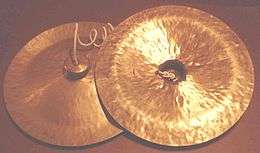
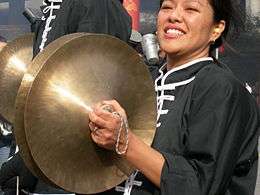
Toy clash cymbals and some others have wooden or plastic handles instead. China type clash cymbals need no handles as the squared bells can be held quite securely without them and are often joined by a cord through the holes in their bells which allows the percussionist to release the bells after striking, producing less damping and greater sustain, and swing the cymbals producing doppler effects.